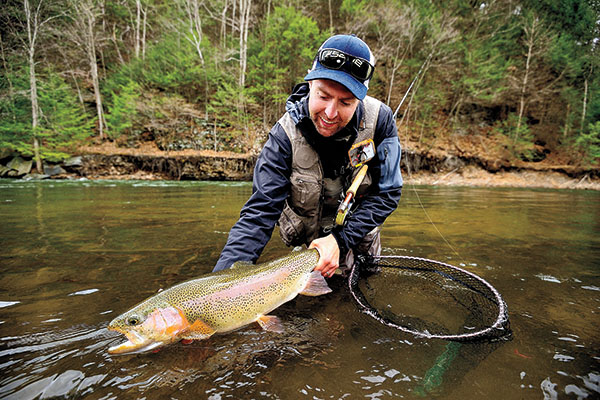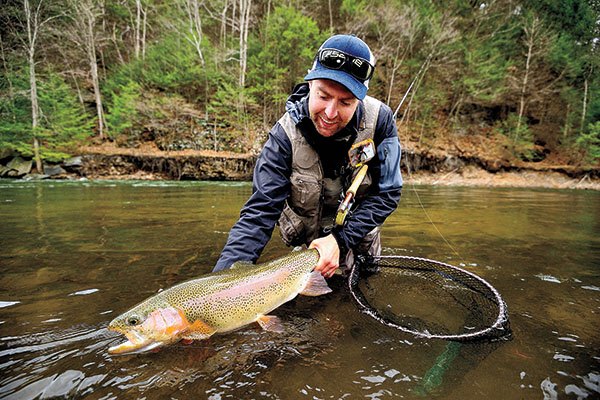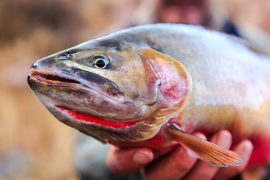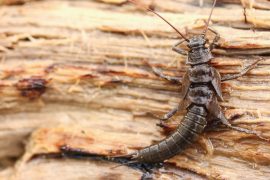
Terrestrial or land-born insects play an important role in the diets of trout throughout the season. These food items include ants, beetles, grasshoppers, cicadas, crickets, and among other things, caterpillars. Wormlike, with spines and covered by hair, or sometimes hairless, caterpillars feed primarily and aggressively on leaves. Spend any time in a forest with a gypsy moth infestation, and you’ll notice that you can actually hear the caterpillars feasting, and the droppings falling out of the infected trees.
The first time I realized how important caterpillars can be to fly fishers was in the early 70s. I was fishing on the upper Huntington, a small freestone trout stream in northeastern Pennsylvania. My favorite pool was an old jack dam that backed up a hip-boot-deep pool for about 50 feet and it always held good numbers of wild brown and brook trout. The right bank was deeply undercut and densely tree-lined, creating the perfect environment of shade and security for the resident trout.
It was a Wednesday afternoon, and as usual I had the afternoon off from working at my parents’ tackle shop. I could hear the trout even before I approached the bottom of the dam. The quickly dissipating wave from the rise gave up a feeding trout’s position. A quick look at the surface showed no clues, so I started by tying on a Parachute Adams.
A cool May wind was blowing as I made my first cast and watched what I thought would be a perfect cast disappear into the trees. A few coaxing tugs and the Adams came free from the tree limb, and then two fish immediately came to the surface and took something with a vicious swirl. I checked my fly and waited to make another cast. I looked to my left, and at eye level was a small green worm hanging from a thin silken thread. It was about an inch long, and with the next wind gust it disappeared into the water.

I watched it float for a short distance, slowly sink to the stream bottom, and then I forgot about it. An hour later and still fishless, I was starting to get a little frustrated. A number of trout continued to feed but not on a regular basis, it was here and there, and my flies went unnoticed. The only observation I could make was that there was more feeding activity after a gust of wind. Whatever these fish were feeding on had to be falling out of the trees. A window of light allowed me to see the backlit glare of another silken string with a green worm attached hanging from a tree branch directly across from me. This could be it! I opened my fly boxes, filled with all kinds of terrestrial patterns, but I had nothing even close to the green worm. There was no question the leaves held a large number of the little green worms, so I collected a few samples and headed home.
That evening at the tying bench I went through my materials trying to match the chartreuse worm, but nothing I had came close. The next day I sent off a sample of the color to E. Hille in Williamsport, Pennsylvania, then a major supplier of tying supplies. Hille responded by sending me a greenish cotton chenille that they thought might work. Thinking that it was not a close enough match, I tried Reed Tackle in New Jersey, and they quickly came back with a nylon chartreuse chenille, which looked almost perfect.
The following Saturday morning found me back on Huntington Creek with a selection of green worms. I checked the trees and the worms were still there, so I quickly geared up and attached one of my new creations. As usual there were a few feeding fish so I added fly floatant to the fly and made a cast. The fly landed and immediately started to sink, which I thought was not good—until the leader straightened out and I almost forgot to react. A few minutes later I held a 12-inch wild brown trout with my green worm firmly planted in his jaw. The next two hours of fishing were almost too easy, simply pop the worm in and get ready to strike. Although I saw trout take floating inchworms, I found that the faster my inchworm sank the better it worked, so I eventually added lead wire under the chenille body with a size 12, 2X-long hook. It was the perfect match to the natural insects.
The next weekend, noted authors Vincent Marinaro and Charlie Meck showed up to fish my home stream, Fishing Creek. I was excited to show them the new worm and have…





